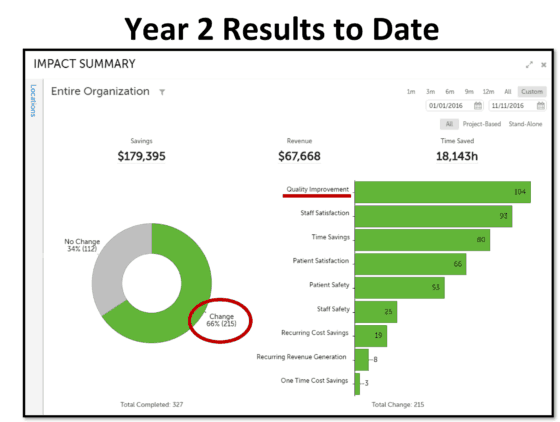Update: See the bottom of the post for the webinar recording.
I get to talk with many people who are leading improvement efforts in different health systems (and, sometimes, in different industries).
Within our KaiNexus team and ecosystem, our VP of Sales, Jeff Roussel, gets to talk to even more people in many different industries. He hears the “voice of the customer” and the “voice of the prospect” and he hears a lot about how this is a busy and stressful time of year for continuous improvement specialists or business leaders who get asked “What was the impact of your improvement efforts in the past year?”
Jeff is giving a free webinar about how to improve your year-end improvement reporting, on Thursday at 1 pm ET. I'll be playing the role of host and moderator. Click here to register.
I had a long chat with Jeff last week about what he's hearing in his sales calls, and here's some of what he talked about…
Many people, in the course of their Lean or continuous improvement “journeys,” are asked by their executives to justify their activities for the year. Organizations make an investment in improvement – they create internal consulting or administration roles, they do training, hire outside consultants, they (hopefully) dedicate employee and leader time to work on improvement.
Right or wrong, they often (usually?) want some sort of report on their Return On Investment (ROI).
It's rare, it seems, when executives give a long runway for an improvement team.
I remember visiting one healthcare organization a few years back. They had been on their self-described “Lean journey” for about five years. I asked the leader of this Lean group what impact they had demonstrated around patient care and benefits to the organization. Lean is a means to an end (or ends), right? It's not just about money… it's about safety, quality, and other important metrics.
“The Bobs” from Office Space might ask:
His answer… to the question about what you've accomplished over the past five years was:
“We've been building capabilities.”
That just doesn't cut it in most organizations, right?
I'm probably preaching to the choir that “it's just the right thing to do” to engage everybody in continuous improvement. But many executives have their habits of saying “show me the money.”
Many people talk to Jeff about the difficult of compiling those results, especially if they're having to do so in a big batch at the end of the year.
Jeff talks to people who describe an onerous process of gathering spreadsheets from people at dozens (and sometimes hundreds) of departments or locations. They do this at the end of the year and they sometimes do so on a weekly or monthly basis throughout the year.
They have to copy and paste and stitch together these different spreadsheets.
It takes a lot of time.
The spreadsheets, even when “standardized,” often break or aren't consistent. The data's inaccurate and not timely.
This means a lot of time for these improvement facilitators and leaders to do administrative stuff instead of actually working on improvement or teaching and coaching others.
Because it's difficult to track results, sometimes Jeff gets this answer when he asks what metrics are being tracked:
“Not much.”
Not being able to track results puts a “Lean program” (or whatever you call it) at risk. When executives aren't as passionate about or as committed to Lean as you are, it runs the risk that they just view Lean and continuous improvement as another competing priority for funding, budgets, and attention.
As one of our customers, Tania Lyon, talked about in her webinar last month:
“…after a while the disadvantages of paper became apparent. “We hit a point where I realized that there was a lot going on in the hospital that was completely invisible to us. The work that was being done in one department was invisible to any other department because it was all on paper and it was managed by a single manager or director,” Dr. Lyon said. “We also had no way of measuring. I couldn't put metrics to our improvement culture.”
So, they started using KaiNexus.
We hear reports from Jeff and our “customer experience” team that customers (lead users in continuous improvement roles):
- “…saved 20 hours a week using KaiNexus” (a hospital improvement leader)
- “… saved 25% of her time using KaiNexus” (a leader in a non-healthcare organization)
KaiNexus customers are not just adding up cost savings. They're also categorizing how many improvements have an impact in different areas.
Tania shared these results, compiled in the KaiNexus platform, in her webinar (click for a larger view):
Not everything can be put into a simple ROI. Not everything is cost savings. Quality improvement matters. Staff satisfaction matters. So does saving time and improving patient satisfaction.
At least she can show results. And it's not super time consuming if that workload of tracking results is spread throughout the organization. Not using spreadsheets, but using a common software platform.
Being able to easily share results with your executives can help build (or maintain) support for the good work you're doing to inspire improvement throughout the organization.
What are you doing here at the end of the year? You might be too busy to read and comment on blog posts, that's for sure!
Here is the recording:
Please scroll down (or click) to post a comment. Connect with me on LinkedIn.
Let’s build a culture of continuous improvement and psychological safety—together. If you're a leader aiming for lasting change (not just more projects), I help organizations:
- Engage people at all levels in sustainable improvement
- Shift from fear of mistakes to learning from them
- Apply Lean thinking in practical, people-centered ways
Interested in coaching or a keynote talk? Let’s talk.
Join me for a Lean Healthcare Accelerator Trip to Japan! Learn More











